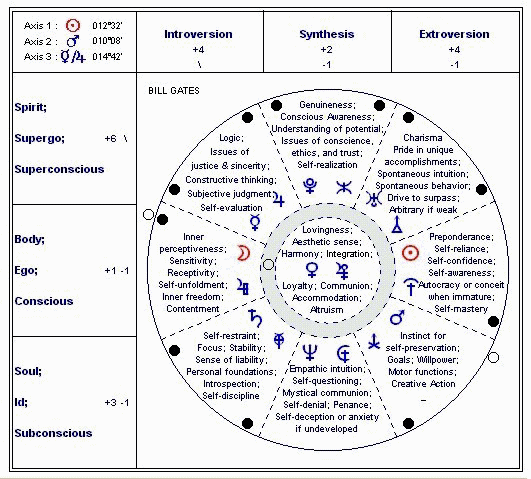The Mandala We use here the same three axes we investigated in Lesson 4 as the foundation for further analytical work. The Mandala is a tool which helps us to analyze the individual via principles of depth psychology: why he or she acts and behaves repeatedly in certain manners, as well how these habits manifest. By doing so, we understand the individual more fully and can advise her or him more effectively. In polarity to Introversion, indicating feelings and inner experiences, stands Extroversion, indicating attitudes and actions in reference to the world outside the self. There is a need for balance between the internal and the external, and this manifests through a process of Synthesis, which serves to reconcile any contradictions. The horizontal levels of the Mandala mark the consciousness levels, which also correspond to the Trinity concepts of Body, Soul, and Spirit. First of all, we must clarify that we work with 22 astrological factors. Four of those are Reference Points: the Earth axis (0° Aries) for dealings out among the general public, the MC for the individual's aspirations, and the Ascendant and Lunar Node for relationships or contacts. The last three of these four are calculated points, referenced to the first, fixed Aries Point. As mathematical reference points, they emit no energies, yet are needed to gauge the planets and transneptunians in their various midpoint relationships. With 10 planets and 8 transneptunians, pairs must be found to correspond to the 9 sectors of the Mandala. In general, there is a transneptunian corresponding to each planet, leaving however one pair which has a special function in the overall schema. The question of how exactly to pair the factors led to much philosophizing and meditation, and the last two pairs to be established were the extroverted pairs Mars.Zeus and Uranus.Vulkanus. It was often asked why Vulkanus was paired with Uranus and not Mars. Uranus and Zeus both command energies which involve intuitive processes, and Mars needs an intuitive complement just as Vulkanus does. This was a major reason for this conclusion. For work with the Mandala, all factors falling along the major axes must be totaled. We need to determine the frequency of occurrence of each individual factor. From the sum of all factors along the axes, the Reference Points are then subtracted. Then, we mark each factor which appears more than 10% of the total, and this is marked with a dot on the Mandala, indicating an emphasis on this factor's energies. If a factor is completely absent from an axis, a small circle or ring is marked on the Mandala, outside the outer circular frame, to indicate its absence. The center circle is slightly different in that absences of Venus or Cupido are marked in the surrounding shaded area which links it to all other sectors. The dots show emphasized factors, and if they are accompanied by a ring, then the factor is considered to be ambivalent. Further clarification of interpretative strategies can be found in the Brummund Technique Book .
Note that the frequency of each individual planet and Transneptunian is derived from the totals given at the end, which ultimately exclude Reference Points themselves from the count (but not the planets or TNs they form midpoints with). For example, at the end of the Mars column, we find 48/44 = 4, meaning that there are 48 factors along the 16th harmonic Mars midpoint axis, but only 44 of those factors are actual planets or transneptunians. This total (which now excludes reference points) is rounded off to the nearest 10, and the 10% frequency count is estimated from there. Thus, the total number of factors (minus Reference Points) for Mars is 44, and after rounding off 44 to 40, we note that Uranus is considered emphasized on this axis, since it occurs 4 times, and Moon and Saturn are emphasized because they both occur 5 times. Both Mars and Venus are missing in one of the three axes. The Moon shows as both emphasized and operating in the shadow (and therefore ambivalent), indicating an inclination to periodic moodiness. Interpretation of the Mandala: 
His sociableness in interaction with others manifests with spontaneity and self-confidence while applying all his might toward his goals. Both his inner and outer life are characterized by his level of intellectual development and he finds equilibrium through self-realization. Venus in the shadow function indicates that he is driven in part by a lack of genuine contentment, and thus his ego may require inner balancing. Ideals coming from the past direct him toward a positive outlook in the intellectual realm, where he, in turn, implements reforms as far as technology allows. Here, he acts on intuition and his subsequent influence provides stimuli for the future. If he lingers too long in the world of ideas, he can be prone to overdo things. At the Conscious level, his only unambivalent emphasis is in the Extroverted sector. The ups and downs of his feelings tend at times to be projected onto his shadowed Venus, in which case his own inner equilibrium is disturbed. In Lesson 4, we assessed Bill's character in terms of all the major axes except the Mars axis. The most challenging part of our work is the synthesized personality assessment. Elements from graphological analysis were brought to consideration in refining the Mandala; more details information on this can be found in the introduction to the Brummund Rulebook . Graphology has been used frequently in both business and public agencies to make key personnel decisions. Astrology has also been deemed as a valid tool for such assessments, and we might propose that, after research and study of the aforementioned techniques and tools, they be used similarly. |
| 下一课 |